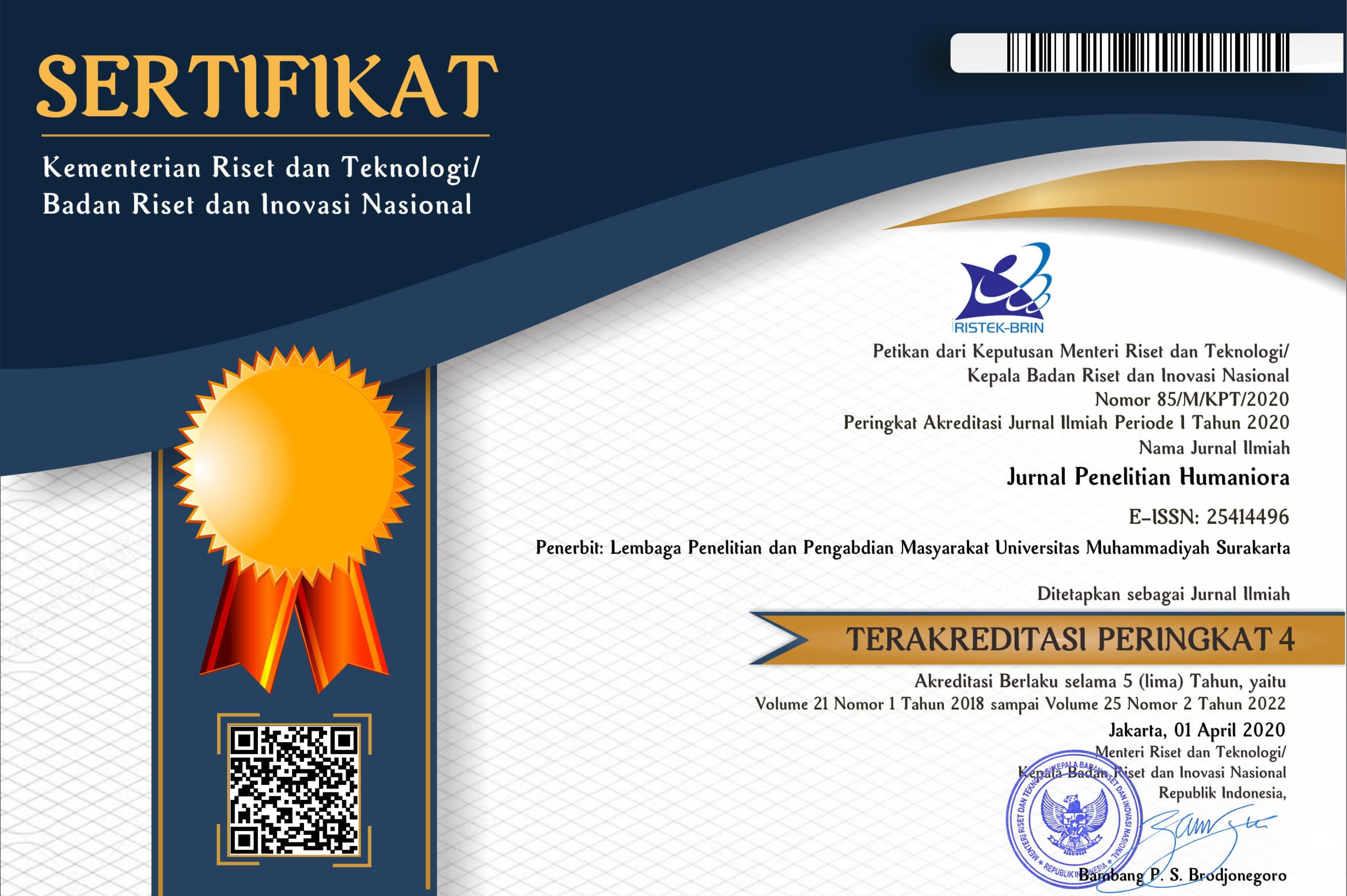The Student Nurses' Written Works of Health Science Institute: Error Analysis in Syntactical and Morphological Category
Somariah Fitriani(1*)(1) University of Muhammadiyah Prof. DR. HAMKA
(*) Corresponding Author
Abstract
The research aims to examine and analyze student nurses’ written works in term of syntax and morphology category. Twenty-six students of the third semester took an English presentation course, which focused on medical cases. The results have revealed that 186 error identifications were found consisting of 132 syntactical errors and 54 morphological errors. The students make errors in the types of article, preposition, parallel structure, the use of be, passive voice, word order, tenses, infinitive to, modal auxiliary and subject determiner in syntactical category. While in morphological error, they make errors in the plural form, subject verb agreement, comparative adjective and word form. Word order is as the most common language error in syntax category with 36 total errors or 19.35% out of 186. The second one is preposition with 26 total errors or 13.97%. While in morphology category, subject verb agreement is the most common one with 29 total errors or 15.59%. The second common one is word form with 13 total errors or 6.98%. It can be concluded that there are 132 (70.96%) of error identification in syntactical category and 54 error identifications or 29.04% in morphological category. In addition to its error identification in syntactical and morphological features, the research has found that the causes of students’ errors are due to intralanguage and interlanguage errors as it has some slightly differences between Bahasa Indonesia and English in term of grammatical structure.
Keywords
Full Text:
PDFReferences
Akande, A.T. (2005). Morphological errors in the English usage of some Nigerian Learners: causes and remedies. Retrieved from morphologyonline.com/documents/Akande 3 Aug05.pdf
Bjorge and Raisanen. (1997). Academic Writing: A university writing course. Lund: Student
literature.
Brown. H. D. (1994). Principles of Language Learning and Teaching. New Jersey: Prentice Hall
Regents.
Carstairs, Andrew – McCarthy. (2002). An Introduction to English Morphology: Words and their
Structure. George Square. Edinburgh: Edinburg University Press.
Chen, H,C. (2000). “Error Analysis of some features of English article usage”. Journal of Wu Feng
Applied Linguistics.
Corder, S.P. (1973). Introducing Applied Linguistics. England: Penguin Education.
Dulay, Heidi, et. al. (1982). Language Two. New York: Oxford University Press.
Fromkin, V., Robert R, & Nina H. (2003). An Introduction to Language. USA: Thomson.
Gas, S.M.; Selinker. (2008). Second Language Acquisition. An Introductory Course. New York:
Routledge.
Hendrickson, James M. (1979). Evaluating Spontaneous Communication Through Systematic Error
Analysis. “Foreign Language Annals 12,5. 357-364
Hourani, T.M.Y. (2008). An Analysis of the Common Grammatical Errors in the English Writing
Made by 3rd Secondary Male Students in the Eastern Coast of UAE. Doctoral Dissertation,
British University in Dubai
James. C. (1988). Errors in Language learning use: Exploring error analysis. Harlow Essec:
Addison Wesley Longman Limited.
Newson, M. (2006). Basic English Syntax with Exercises. Rusia: Nemzeti
Nunan, David. (2005). Practical English Language Teaching: Grammar. Singapore: McGraw-Hill.
Nordquist, R. (2015). Glossary of grammatical and Rhetorical Terms. Updated December 16,
Retrieved on 3 January 2016
from http://grammar.about.com/od/rs/g/syntax.htm
Radford, A. (2009). Analysing English Sentences: A Minimalist Approach. New York: Cambridge University Press
Richards, J.C., and Schmidt, R. (2002). Dictionary of Language Teaching & Applied Linguistics. Pearson Education Limited.
London:Longman
Ellis, R. (1996). Understanding Second language Acquisition. Oxford: Oxford University Press.
Ellis, R. (2008). The study of Second Language Acquisition. Oxford: Oxford University Press.
Richards, J.C., (1971). “A Non-Contrastive Approach to Error Analysis,”English Language
Teaching, 25, No.3 (June 1971)
Richards, J. C. (1972). Error Analysis. UK: Cambridge Corder Longman Group.
Slonneger, Kenneth., Barry L. Kurtz. (1995). Formal syntax and semantics of programming
languages: a laboratory based
approach. USA: Addison-Wesley Publishing Company, Inc.
Ulijn and Strother (1995). Communication in Business and Technology. Frankfurt:lang.
Vacide, Erdogan. (2005). Contribution of Error Analysis to foreign Language Teaching.
http://efd.mersin.edu.tr/dergi/meuefd/pdf.
Article Metrics
Abstract view(s): 353 time(s)PDF: 413 time(s)
Refbacks
- There are currently no refbacks.











